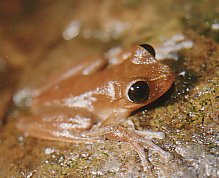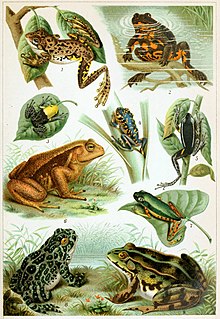
Nyctimystes is a genus of tree frog in the family Hylidae. They are principally Papuan species, but do inhabit islands in the Moluccas Previously recorded in Australia, a revision of the species dayi places them within the creek frog clade and currently places this species in the genus Litoria. All species in this genus have one distinct feature that separates them from other species in the Hylidae, the lower eyelid is marked with pattern of lines, veins, or dots. This feature presumably acts as camouflage when the frogs are at rest during the day.
Nyctimystes avocalis is a species of frog in the family Pelodryadidae, also treated as the subfamily Pelodryadinae in the family Hylidae. It is endemic to Papua New Guinea and is only known from its type locality on the east slope of Goodenough Island, one of the D'Entrecasteaux Islands. Common name loud big-eyed treefrog has been coined for it.

Nyctimystes daymani, also known as the Dayman big-eyed treefrog, is a species of frog in the family Pelodryadidae, also treated as the subfamily Pelodryadinae in the family Hylidae. It is endemic to Papua New Guinea and known from its type locality, Mount Dayman in the Milne Bay Province, easternmost mainland New Guinea. Records from further west are uncertain.
Nyctimystes disruptus, the Madang big-eyed tree frog, is a species of frog in the family Hylidae, endemic to Papua New Guinea. Its natural habitats are subtropical or tropical moist montane forests and rivers.
Nyctimystes fluviatilis, also known as the Indonesian big-eyed tree frog, is a species of frog in the family Pelodryadidae, also treated as the subfamily Pelodryadinae in the family Hylidae. It is endemic to New Guinea and is known from Idenburg River and Wapoga River in Papua province, Indonesia, and from the Torricelli Mountains in the East Sepik Province and Kavorabip in the Western Province, both in the western Papua New Guinea.

Grant's big-eyed tree frog is a species of frog in the family Hylidae found in West Papua in Indonesia and possibly Papua New Guinea. Its natural habitats are subtropical or tropical moist lowland forests and rivers.
Nyctimystes gularis, the Mondo big-eyed tree frog, is a species of frog in the family Hylidae, endemic to Papua New Guinea. Its natural habitats are subtropical or tropical moist montane forests and rivers.
Nyctimystes foricula, the Kaironk big-eyed tree frog, is a species of frog in the family Hylidae, endemic to Papua New Guinea. Its natural habitats are subtropical or tropical moist montane forests, rivers, rural gardens, and heavily degraded former forests.
Nyctimystes humeralis, the green big-eyed tree frog, is a species of frog in the family Hylidae, found in West Papua in Indonesia and Papua New Guinea. Its natural habitats are subtropical or tropical moist lowland forests, subtropical or tropical moist montane forests, and rivers.
Nyctimystes kubori is a species of frog in the family Pelodryadidae, also treated as the subfamily Pelodryadinae in the family Hylidae. It is endemic to Papua New Guinea and is widespread in the New Guinea Highlands between 141°E and 147°E and in the mountains of the Huon Peninsula. The specific name kubori refers to its type locality in the Kubor Mountains. Common name sandy big-eyed treefrog has been coined for this species.

Nyctimystes montanus is a species of frog in the subfamily Pelodryadinae, family Hylidae, or alternatively, family Pelodryadidae. It is endemic to the Arfak Mountains, located in the Bird's Head Peninsula of northwestern New Guinea. Administratively, the area belongs to the West Papua province, Indonesia. This species is only known from its type locality. There are no records of this species after it was described in 1878, perhaps because of lack of surveys.
Nyctimystes obsoletus, the Simbang big-eyed tree frog, is a species of frog in the family Hylidae, endemic to Papua New Guinea. Its natural habitats are subtropical or tropical moist lowland forests and rivers.
Nyctimystes papua, the Papua big-eyed tree frog, is a species of frog in the family Hylidae, endemic to Papua New Guinea. Its natural habitats are subtropical or tropical moist montane forests and rivers.
Nyctimystes persimilis, also known as the Milne big-eyed treefrog, is a species of frog in the family Pelodryadidae, also treated as the subfamily Pelodryadinae in the family Hylidae. It is endemic to Papua New Guinea and known from Mount Dayman and Mount Simpson in the Owen Stanley Range.
Nyctimystes pulcher, the spurred big-eyed tree frog, is a species of frog in the family Hylidae, found in West Papua in Indonesia and Papua New Guinea. Its natural habitats are subtropical or tropical moist lowland forests, subtropical or tropical moist montane forests, and rivers.
Rueppel’s big-eyed tree frog is a species of frog in the family Hylidae. It is endemic to Indonesia. Its natural habitats are subtropical or tropical moist lowland forests, subtropical or tropical moist montane forests, and rivers. It is threatened by habitat loss.
Nyctimystes semipalmatus, the Kokoda big-eyed tree frog, is a species of frog in the family Hylidae, endemic to Papua New Guinea. Its natural habitats are subtropical or tropical moist lowland forests, rivers, and heavily degraded former forests.
Nyctimystes trachydermis, the Morobe big-eyed tree frog, is a species of frog in the family Hylidae, endemic to Papua New Guinea. It occurs in the mountains of southern eastern New Guinea. Its type locality is Gapaia Creek, at 1,280 m (4,200 ft) asl between Garaina and Saureli, in the Morobe Province. The specific name trachydermis means "rough skinned", derived from the Greek words trachys and derma.
Tyler’s big-eyed tree frog is a species of frog in the family Hylidae, endemic to Papua New Guinea. It is only known from its type locality, Gapaia Creek, at 1,280 m (4,200 ft) asl between Garaina and Saureli, in the Morobe Province. The specific name honours Michael J. Tyler, an Australian herpetologist, "in recognition of his notable contributions to the systematics of Australo-papuan frogs."
Nyctimystes zweifeli, or Zweifel’s big-eyed tree frog, is a species of frog in the family Hylidae, endemic to Papua New Guinea. Its natural habitats are subtropical or tropical moist montane forests and rivers.








